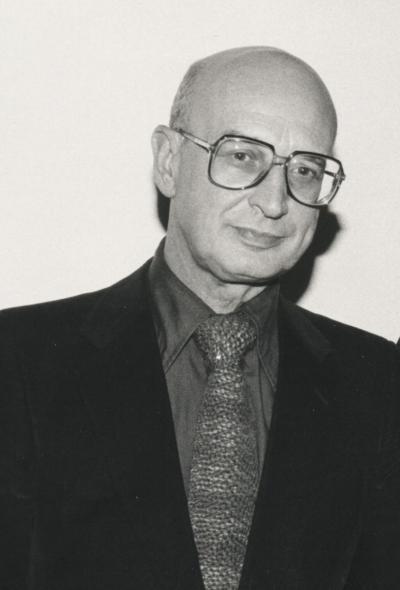Witold Szalonek (1927–2001)

Without a doubt Professor Witold Szalonek was one of the most original Polish composers of the 20th century, and his work on music theory aroused a great deal of attention. His ideas on composition influenced young composers at the Berlin Academy of Arts (until 2001, after that University of the Arts) for almost 20 years.
When Witold Szalonek took up the post of professor at the Berlin Academy of Arts in 1973 at the age of 50 he was already an internationally well-known Polish composer. The Berlin Academy of Arts also enjoyed a huge international reputation. The fact that great Polish musicians and composers had also studied at the Academy – these included Mieczysław Karłowicz (1876–1909), Ludomir Różycki (1883–1953) and Stanisław Moniuszko (1819–1872) – was an additional spur for Witlod Szalonek to apply for the post of professor. Despite competition from 40 other applicants he was awarded the post, a fact that bears witness to his extraordinary quality as a composer and huge experience as an educationalist. Here in Berlin he not only enjoyed an intense creative period but was also powerfully committed to his educational work and to popularising Polish composers, including those who were also active in the West like Roman Palester, Andrzej Panufnik and Antoni Szałowski. In 1982 Witold Szalonek was also a co-founder of the Szymanowski Club in Berlin (Towarzystwo im. Szymanowskiego w Berlinie), whose aim was to popularise contemporary and recent Polish composers.
But lovers of music still connect Witold Szalonek primarily with sonorism – the search for the musical soul of an instrument, as Witold Szalonek liked to put it. Music science describes sonorism in somewhat cooler tones as a sound-orientated style in new music. In Poland this style was particularly strongly represented in the 1960s and 1970s. Other Polish composers like Witold Lutosławski (1913–1994), Henryk Górecki (1933–2010) and Krzysztof Penderecki (born 1933) were also influenced by sonorism. But none of them where as rigorous as Witold Szalonek, because for him the principle aim was not the sound itself but its liberation from all musical systems to date. Witold Szalonek discovered sonorism amongst older Polish composers. For him the modern sound of the piano, the most typical instrument of European culture, had its beginnings in the universal creations of Frederic Chopin (1810–1849). According to Szalonek the famous Polish composer liberated the “sound soul” of the piano.
Witold Szalonek also discovered “combined sounds”, a polyphony of specific tone colours in woodwind instruments. “Combined sounds” arise in Szalonek’s work, firstly by means of a specific blowing technique, secondly by combining the valves, levers and openings of an instrument, and thirdly by the interplay between the two techniques. One of Witold Szalonek’s greatest services to theoretical and practical work is the corresponding notation of his composition techniques.
Witold Szalonek was employed at the Berlin Academy of Arts until his retirement in 1992 as an Emeritus Professor. After that he devoted most of his time to composing. Witold Szalonek died on 12th October 2001 in Berlin. His last wish was that his urn should be buried in his parents family grave in the cemetery in Łagiewniki Ślaskie (now a suburb of Bytom/Beuthen).
Adam Gusowski, February 2016
